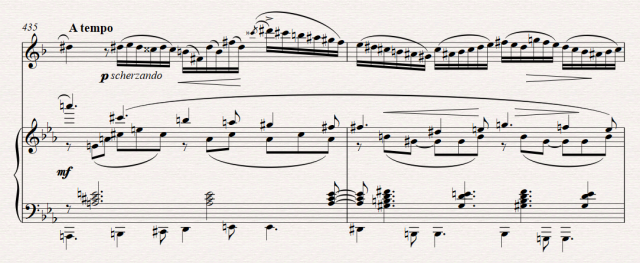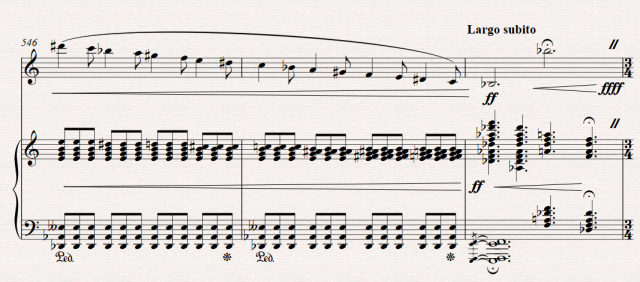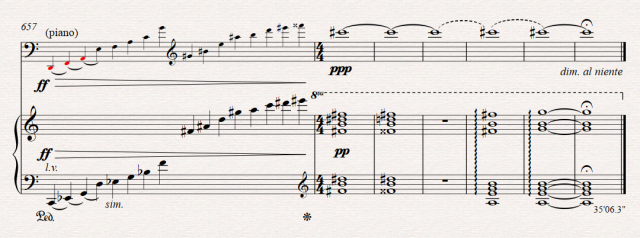This is the second in an ongoing series of posts reflecting on some formative aspects of both myself and my music. Part 1 examined my intellectual development, while this post deals with the effects of the experience of my mother’s death from the same period and my subsequent emergence as both a person and as a composer. I meant to finish this within a few days of the first part, but it has proven quite difficult to write. Part 3 will address more recent changes in my music and ideas.
Here, then, lies the difference: modern aesthetics is an aesthetic of the sublime, though a nostalgic one. It allows the unpresentable to be put forward only as the missing contents; but the form, because of its recognizable consistency, continues to offer to the reader or viewer matter of solace and pleasure. Yet these sentiments do not constitute the real sublime sentiment, which is an intrinsic combination of pleasure and pain: the pleasure that reason should exceed all presentation, the pain that imagination or sensibility should not be equal to the concept.
Jean-François Lyotard, “Answering the Question: What Is Postmodernism?″ translated by Régis Durand in The Postmodern Condition: A Report on Knowledge, translated by Geoff Bennington and Brian Massumi. Minneapolis: University of Minnesota Press, 1984, p. 81.
This past winter marked the tenth anniversary of my mother’s death. This is not something I have discussed very much with anyone, and will come as a surprise to most people that know me. Why am I sharing this is in so public a forum? First of all, it has become increasingly obvious to me that I have not come to terms with her death, and I feel as though talking about it (or at least related moments from that time in my life) might help. Secondarily, in light of the previous point, I think that opening up here will give those who know me (and read this blog) some important perspective on how these events have affected who I am and what I do.
My mother, Dorothy Christine Cole, was first diagnosed with leukemia in 2002, when I was 12 years old. After several months of chemotherapy, she successfully went into remission and would remain healthy for more than 2 years. In late October 2004 she fell ill and tests showed that her cancer had returned. She was quickly taken to Vancouver General Hospital, where she spent the next two months before it became clear that the chemotherapy would not prove effective a second time. I was only able to see her a couple times in the hospital before my family ended up spending Christmas in Vancouver to be with her. In early January 2005 she was taken by air ambulance back to Kamloops where she stayed at first the Royal Inland Hospital and then the Kamloops Hospice, before she passed away on January 16.
However, this post is not explicitly about her death—this is not the place for that, and I may not be ready to fully confront it. It is about the circumstances surrounding it and the music that came out of that period, which I believe I am ready to address at this point. I will begin by examining in detail the clarinet sonata I wrote during this time and then trying to make sense of what I was going through before and while composing it.
It was about a month after my mother’s death that I started my first foray into serious composing. I had composed a few things before this point, the most substantial of which was a pseudo-classical piano sonata in D minor, but sometime in the fall of 2004 I started writing a clarinet sonata based on a transitional section of Liszt’s Piano Concerto No. 1. I started work on it in earnest in February 2005 and spent nearly the entire year completing it. What resulted is Sonata Flebile, which is a 35-minute piece for clarinet and piano. It draws thematically from Liszt, both Piano Concerto No. 1 and Nuages gris, but it is also inspired by a lot of other music I was listening to at the time: late-period Liszt, Beethoven, Mahler, Chopin, Brahms, etc. You can view the score and play back a horrible MIDI realization here (if you have the Scorch plugin), but I recommend listening instead to the final Chaconne, which is probably the only salvageable part, here played by Liam Hockley and Kevin Thomson:
Looking back at this piece, the most striking aspect for me is its structure, which is partially based on Liszt’s Sonata in B minor, but is considerably more elaborate. It is nominally a distended sonata form, but can be broken down as follows:
- Fantasia (subtitled contradictory, juxtaposed circumstances) which forms a free introduction to
- Theme and variations (self-reflection, contemplation of the innumerable facets), which is also the core of the sonata form:
- Exposition: Theme and Variations 1-3
- Development: Variations 4-10 of which
- Variations 4-6 are free development and
- Variations 7-10 are a double fugue, which is also in sonata form:
- Exposition: Variations 7 & 8 (each is a full fugue exposition of one of the two themes)
- Development: Variation 9
- Recapitulation and Coda: Variation 10 (both themes return simultaneously)
- Retransition and Recapitulation: Variations 11-14
- Ciaccona (understanding: finality, loss) as a coda to the work, itself a ground with 7 variations and coda.
At this point, I am quite sure that the structure of the piece was in some way therapeutic. In order to avoid the emotions I was experiencing, I drew on my intellectual experience with math and created something which emphasized structural rigour, while still comfortingly familiar in its musical foundations. A connection to the common-practice tradition via classical forms of sonata-allegro and variation, but combined in a particularly potent nested structure, proved extremely intoxicating to my desire for things to make sense.
Another striking element of the piece, for me, is the subtitles of the sections. The contradictory, juxtaposed circumstances were clearly the raw emotions I felt at the time of its composition—grief, but also intense adolescent infatuation, which was first manifesting in me at around the same time. The subtitles form a sort of idealized process of grieving, where I imagined that self-reflection, contemplation of the innumerable facets would eventually be followed by understanding: finality, loss and some sort of closure.
However, as those who have gone through the grieving process know, things are not so simple. Most of what transpired those few months is a blur. I can remember only a handful of fleeting images: short, disconnected conversations, seeing the Vancouver Opera do Madama Butterfly after a hospital visit, finding The Rise and Fall of the Third Reich on a shelf at the house where we were staying and reading its roughly 1200 pages in less than three days. Numbness alternated with an intense sensation of poetry and meaningfulness. It is difficult to chart one’s progress in an idealized process when continuity does not seem to exist at all. The dissonance between the idealism of the piece’s construction and the way I actually felt at the time illustrates its fundamental problems.
Not long after I finished writing it, I began to realize that Sonata Flebile had many major flaws. I was not capable of really handling the grandiosity of the piece’s structure at the time, which I came to realize was itself not really appropriate for the biographical nature of the piece’s inspiration anyhow. On top of that, it is really unnecessarily difficult—neither the pianist nor the clarinettist gets much of a break for the entire 35-minute duration and the piano part has too many simultaneous voices most of the time. None of those things were enough to make me regret writing the piece, but the realization that its construction was diametrically opposed with my actual experience of mourning effectively killed any interest I had in it. This realization had set in fairly strongly by the time that I first performed a portion of the piece in the spring of 2007. It is only after many years of reflection that I have realized its value as an artifact of a particular time in my life, one that I can examine when I am incapable of examining my experience of that time.
I still consider myself to have learned how to compose by writing Sonata Flebile, and not just in the mechanical sense; from it, I also somewhat paradoxically learned how not to compose. Not only did my realization about the philosophy of the piece’s structure effectively banish it from my mind, it also radically altered my notion of what composition is. This realization can be seen as the effective end of both naked formalism and any 19th-century influence in my compositions. I started writing some serial pieces not long afterwards, but they always had some sort of subversion of their system. Though there is some nascent polystylism in Sonata Flebile, I started to explore it more in earnest afterwards, but that will be for another post.
Returning to the work’s subtitles, I have come to realize that the most important thing I learned from the whole process has formed the foundation of my philosophical perspective ever since: life is actually made up of continuous contradictory, juxtaposed circumstances, and no amount of self-reflection can resolve them. This post may sound somewhat cold and analytical to some, but that is an ongoing related issue of mine. The emotional and the intellectual have been conflated for me since this time in my life in nearly every way: I have intellectualized my emotional life, seeking to make sense of it (such as in this post), but also have found great joy and sorrow in often esoteric and abstruse music and writing. This may have been detrimental to my personal life, but, as Schoenberg wrote, what is music but a union of “heart and brain?”








